The MSI Z97A Gaming 6 Motherboard Review
by Ian Cutress on July 24, 2015 9:00 AM EST- Posted in
- Motherboards
- Gaming
- MSI
- Z97
Gaming Performance 2015
Our 2015 gaming results are still relatively new, and thus along with the motherboards tested we are also including some other CPU results for completeness.
Alien: Isolation
If first person survival mixed with horror is your sort of thing, then Alien: Isolation, based off of the Alien franchise, should be an interesting title. Developed by The Creative Assembly and released in October 2014, Alien: Isolation has won numerous awards from Game Of The Year to several top 10s/25s and Best Horror titles, ratcheting up over a million sales by February 2015. Alien: Isolation uses a custom built engine which includes dynamic sound effects and should be fully multi-core enabled.
For low end graphics, we test at 720p with Ultra settings, whereas for mid and high range graphics we bump this up to 1080p, taking the average frame rate as our marker with a scripted version of the built-in benchmark.
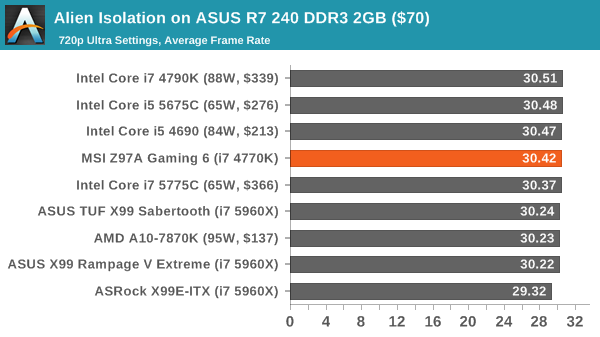
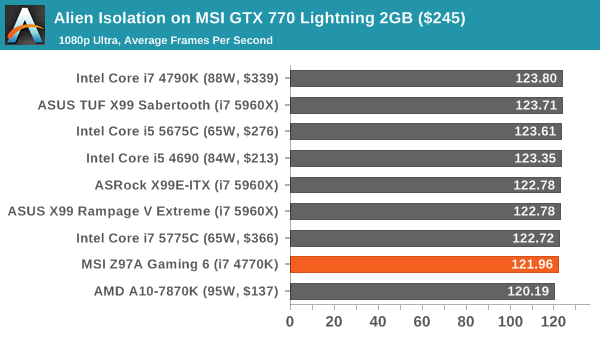
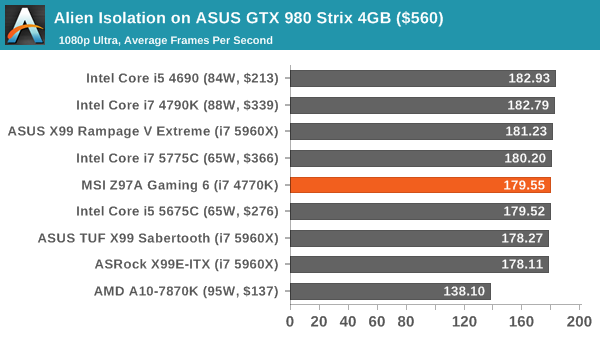
Total War: Attila
The Total War franchise moves on to Attila, another The Creative Assembly development, and is a stand-alone strategy title set in 395AD where the main story line lets the gamer take control of the leader of the Huns in order to conquer parts of the world. Graphically the game can render hundreds/thousands of units on screen at once, all with their individual actions and can put some of the big cards to task.
For low end graphics, we test at 720p with performance settings, recording the average frame rate. With mid and high range graphics, we test at 1080p with the quality setting. In both circumstances, unlimited video memory is enabled and the in-game scripted benchmark is used.
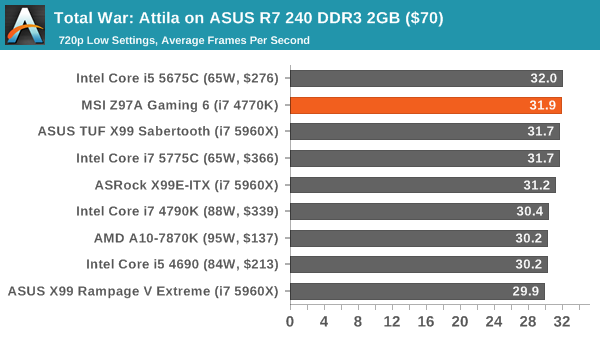
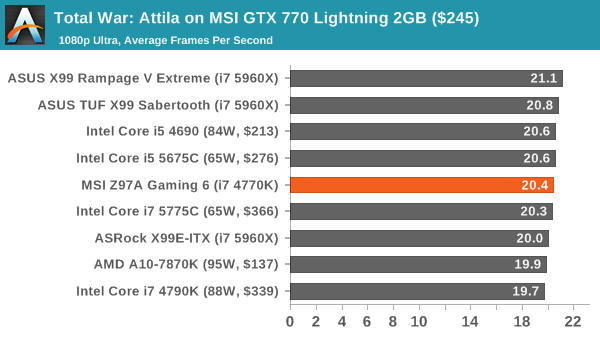
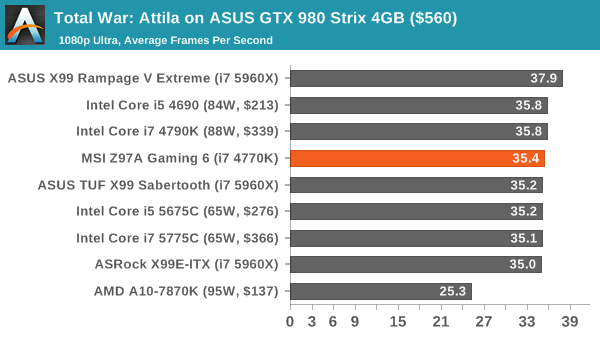
Grand Theft Auto V
The highly anticipated iteration of the Grand Theft Auto franchise finally hit the shelves on April 14th 2015, with both AMD and NVIDIA in tow to help optimize the title. GTA doesn’t provide graphical presets, but opens up the options to users and extends the boundaries by pushing even the hardest systems to the limit using Rockstar’s Advanced Game Engine. Whether the user is flying high in the mountains with long draw distances or dealing with assorted trash in the city, when cranked up to maximum it creates stunning visuals but hard work for both the CPU and the GPU.
For our test we have scripted a version of the in-game benchmark, relying only on the final part which combines a flight scene along with an in-city drive-by followed by a tanker explosion. For low end systems we test at 720p on the lowest settings, whereas mid and high end graphics play at 1080p with very high settings across the board. We record both the average frame rate and the percentage of frames under 60 FPS (16.6ms).
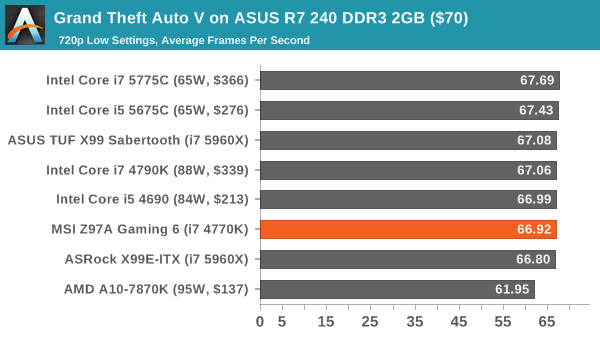

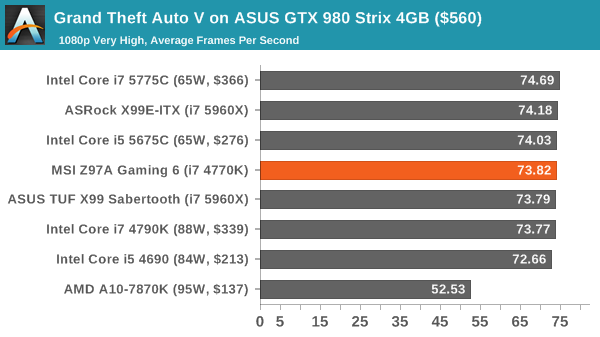
GRID: Autosport
No graphics tests are complete without some input from Codemasters and the EGO engine, which means for this round of testing we point towards GRID: Autosport, the next iteration in the GRID and racing genre. As with our previous racing testing, each update to the engine aims to add in effects, reflections, detail and realism, with Codemasters making ‘authenticity’ a main focal point for this version.
GRID’s benchmark mode is very flexible, and as a result we created a test race using a shortened version of the Red Bull Ring with twelve cars doing two laps. The car is focus starts last and is quite fast, but usually finishes second or third. For low end graphics we test at 1080p medium settings, whereas mid and high end graphics get the full 1080p maximum. Both the average and minimum frame rates are recorded.
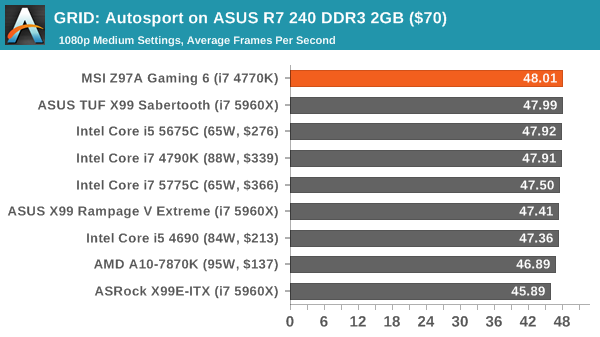
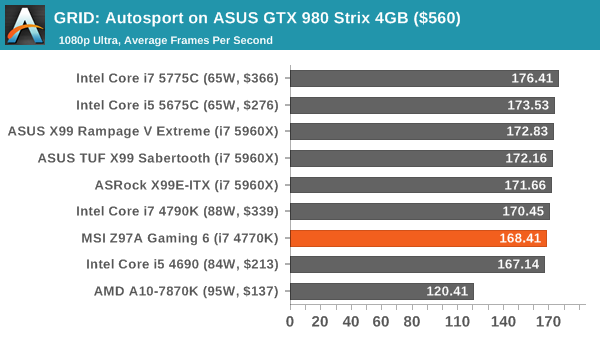

Middle-Earth: Shadows of Mordor
The final title in our testing is another battle of system performance with the open world action-adventure title, Shadows of Mordor. Produced by Monolith using the LithTech Jupiter EX engine and numerous detail add-ons, SoM goes for detail and complexity to a large extent, despite having to be cut down from the original plans. The main story itself was written by the same writer as Red Dead Redemption, and it received Zero Punctuation’s Game of The Year in 2014.
For testing purposes, SoM gives a dynamic screen resolution setting, allowing us to render at high resolutions that are then scaled down to the monitor. As a result, we get several tests using the in-game benchmark. For low end graphics we examine at 720p with low settings, whereas mid and high end graphics get 1080p Ultra. The top graphics test is also redone at 3840x2160, also with Ultra settings, and we also test two cards at 4K where possible.
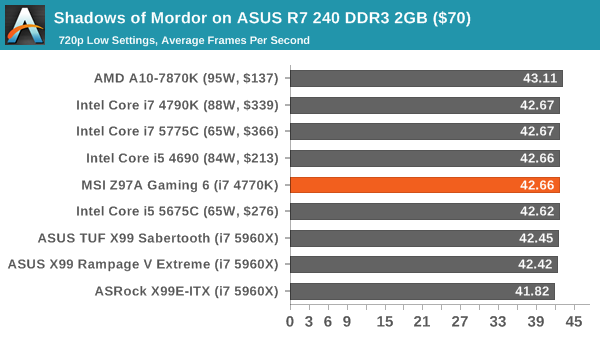

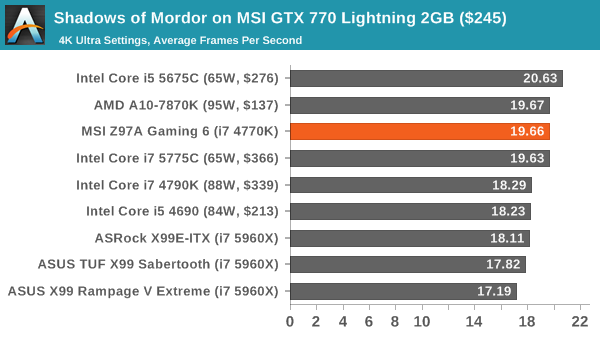
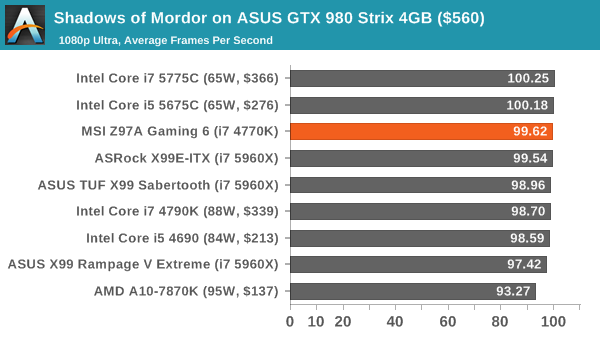
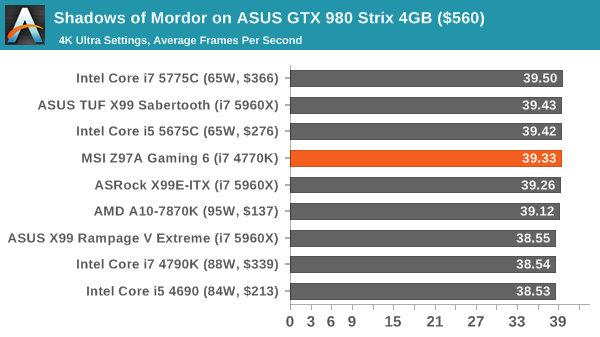
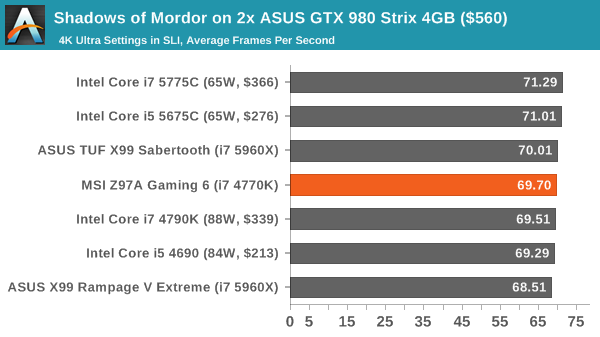















14 Comments
View All Comments
hansmuff - Friday, July 24, 2015 - link
I'm a little disappointed that the UEFI seemingly wasn't reviewed.hansmuff - Friday, July 24, 2015 - link
And yes I see "take a look at our MSI Z97 Gaming 5 review or our MSI Z97 Guard Pro review for a more detailed analysis." Has nothing at all changed?Refuge - Friday, July 24, 2015 - link
Not really sure what is confusing about."nothing new from our previous analysis"
Seems pretty clear cut and simple to me.
LoganPowell - Friday, November 27, 2015 - link
Good observation! I was also personally not very impressed with it. I recommend going for the CybertronPC Patriot instead. It's extremely highly rated among users (see http://www.consumerrunner.com/top-10-best-desktops... for example...)MrCommunistGen - Friday, July 24, 2015 - link
The last paragraph of "MSI Z97A Gaming 6 Overview" on page 1 as well as the last section of page 1 "BIOS and Software" mention it.It is a little ambiguous whether it is identical to previous iterations, or if only minor changes have been made, but Ian does say: "The conclusions are still the same..."
Shadowmaster625 - Friday, July 24, 2015 - link
One USB 3.1 port? ONE? HAAHHAHA. It looks so stupid sitting in that row all by itself. What are these guys thinking?thudo - Friday, July 24, 2015 - link
Yeah thats truely pathetic. USB3.0 dead dead D-E-A-D while 3.1 is vastly superior in all ways to that olde has-been. All the USB3.0 should have, at a minimum, been replaced with USB3.1 Type-A connectors.. For shame.. >:[tabascosauz - Friday, July 24, 2015 - link
HahahahahahOr maybe there isn't space on the board for that many third party controllers? Hmmm?
CrazyElf - Friday, July 24, 2015 - link
To be honest, at this price point, I'd recommend paying a bit extra to get the MSI Gaming 7. You get a better VRM (12 phase - 6 doubled), a lot better rear IO panel, and a few other features.I just wish this thing shipped with an Intel LAN I218V or something similar. These Killer NICs I find tend to be more trouble than they are worth. None of them hold up a candle to Intel's server grade NICs either.
Of course, I personally prefer to get OC oriented boards like the Asrock OC Formula, Gigabyte SOC Force, or similar boards, but that's just me. To me, most of these "gaming"boards aren't too good.
DigitalFreak - Friday, July 24, 2015 - link
At this point I'd wait for Skylake.